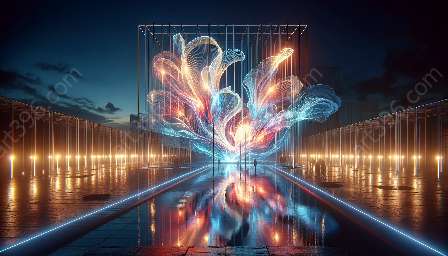Light art installations showcase the interplay between visual perception and psychological responses. As our minds interpret and react to light in art, the field of psychology provides insights into how we experience these captivating displays.
The Influence of Psychology on Light Art Perception
Psychology plays a crucial role in shaping our perception of light art installations. The way our brains process visual information, including light and color, directly impacts how we engage with and interpret these mesmerizing artworks.
1. Sensation and Perception
Our sensation of light and its perception are deeply intertwined with psychological processes. The field of psychophysics delves into how we detect and interpret physical stimuli, such as the intensity and color of light, and how our sensory experiences influence our emotional and cognitive responses.
2. Emotional and Aesthetic Responses
Light art installations elicit emotional and aesthetic responses, and psychology offers valuable insights into why we feel a particular way when immersed in these displays. The interplay between light, color, and psychological factors like mood, memory, and cultural influences shapes our emotional and aesthetic experiences with light art.
3. Attention and Focus
Psychological theories of attention and focus shed light on how our minds engage with light art installations. Understanding how we direct and sustain attention toward different elements of these installations enhances our appreciation and comprehension of the visual richness presented through light-based artworks.
The Interplay between Light, Perception, and Art
Light art blurs the boundaries between science, psychology, and artistic expression. By exploring the relationship between light, perception, and art in the context of psychology, we gain a deeper understanding of how these elements intertwine to create impactful sensory experiences.
1. Visual Illusions and Optical Effects
Psychology assists in unraveling the visual illusions and optical effects embedded within light art installations. Understanding how our brains process ambiguous visual stimuli and how light can create illusions enriches our appreciation for the intricacies of light-based artworks.
2. Spatial and Environmental Considerations
Psychological aspects related to spatial perception and environmental influences inform our engagement with light art installations within specific settings. Factors such as depth perception, environmental lighting, and viewers' spatial relationships contribute to the overall psychological experience of light art.
3. Cross-Cultural and Social Influences
Psychology offers valuable perspectives on how cross-cultural and social factors shape our perception of light art installations. By examining how individuals from different backgrounds and social contexts interpret and react to light-based artworks, we gain insights into the diverse psychological dimensions of experiencing these captivating installations.
Enhancing the Light Art Experience through Psychology
Ultimately, psychology serves as a framework for understanding and enhancing the immersive experience of light art installations. By integrating psychological principles, artists, designers, and curators can create thought-provoking and impactful displays that resonate with the complexities of human perception and cognition, enriching our encounters with light art.

